Digital Business & New Technologies: E-commerce Report Analysis
VerifiedAdded on 2023/01/12
|11
|2845
|88
Report
AI Summary
This report provides a comprehensive overview of e-commerce, examining its significance, evolution, and the various technologies employed in its operation. It delves into the importance of e-commerce in modern business, highlighting its cost-effectiveness and time-saving benefits compared to traditional transactions. The report explores the historical development of e-commerce, from its early beginnings to its current state, including the technological advancements that have facilitated its growth. It also details the different technologies and platforms used in e-commerce, such as web servers, web tools, and various software options like shopping cart software and CRM tools. Furthermore, the report discusses the organizations that utilize e-commerce and the ways in which it serves as a business tool, emphasizing its ability to streamline transactions and expand business reach. Finally, the report establishes the relationship between digital technologies and theories of business and management structure, comparing and contrasting digital business and e-commerce to illustrate their interdependencies and mutual benefits.
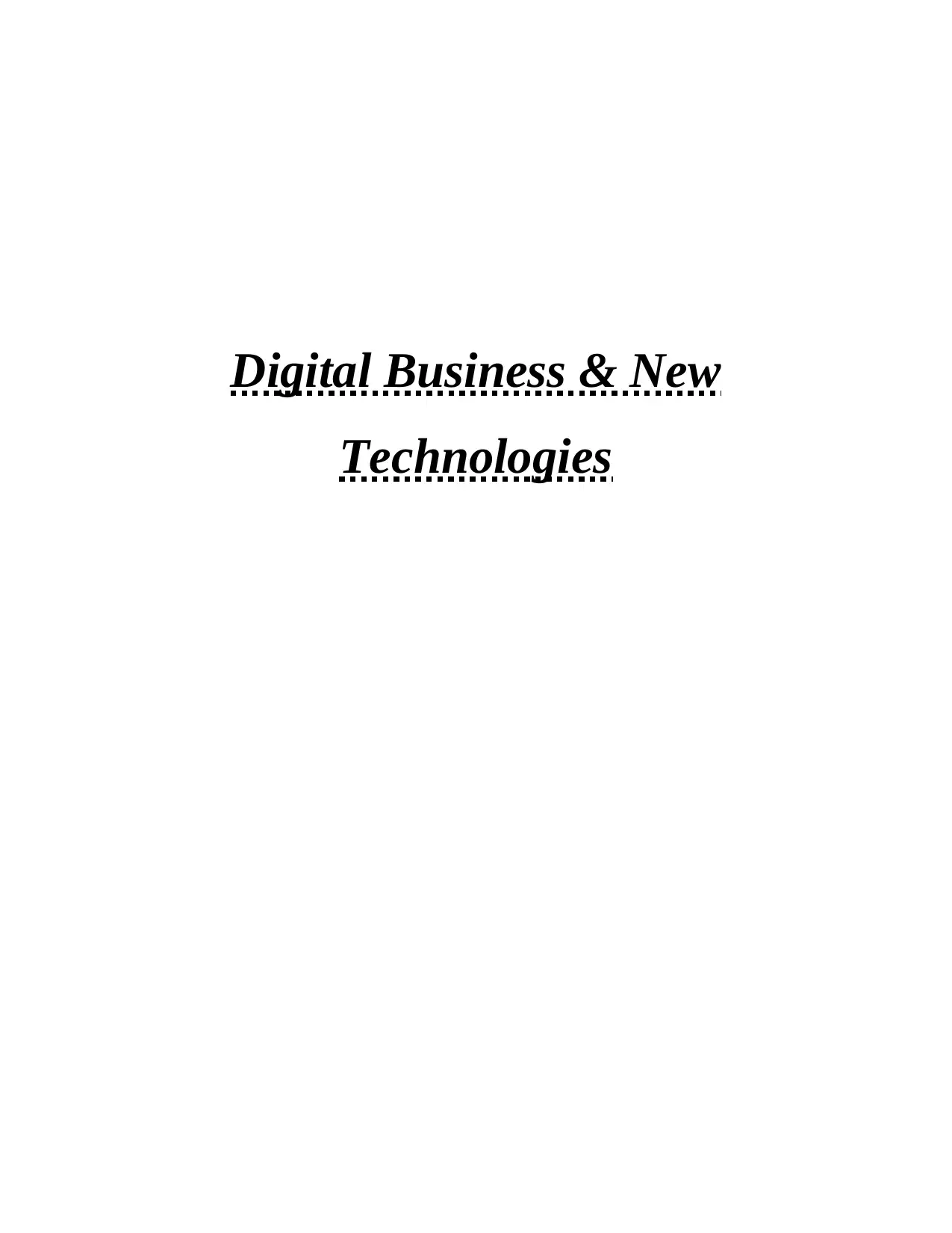
Digital Business & New
Technologies
Technologies
Paraphrase This Document
Need a fresh take? Get an instant paraphrase of this document with our AI Paraphraser
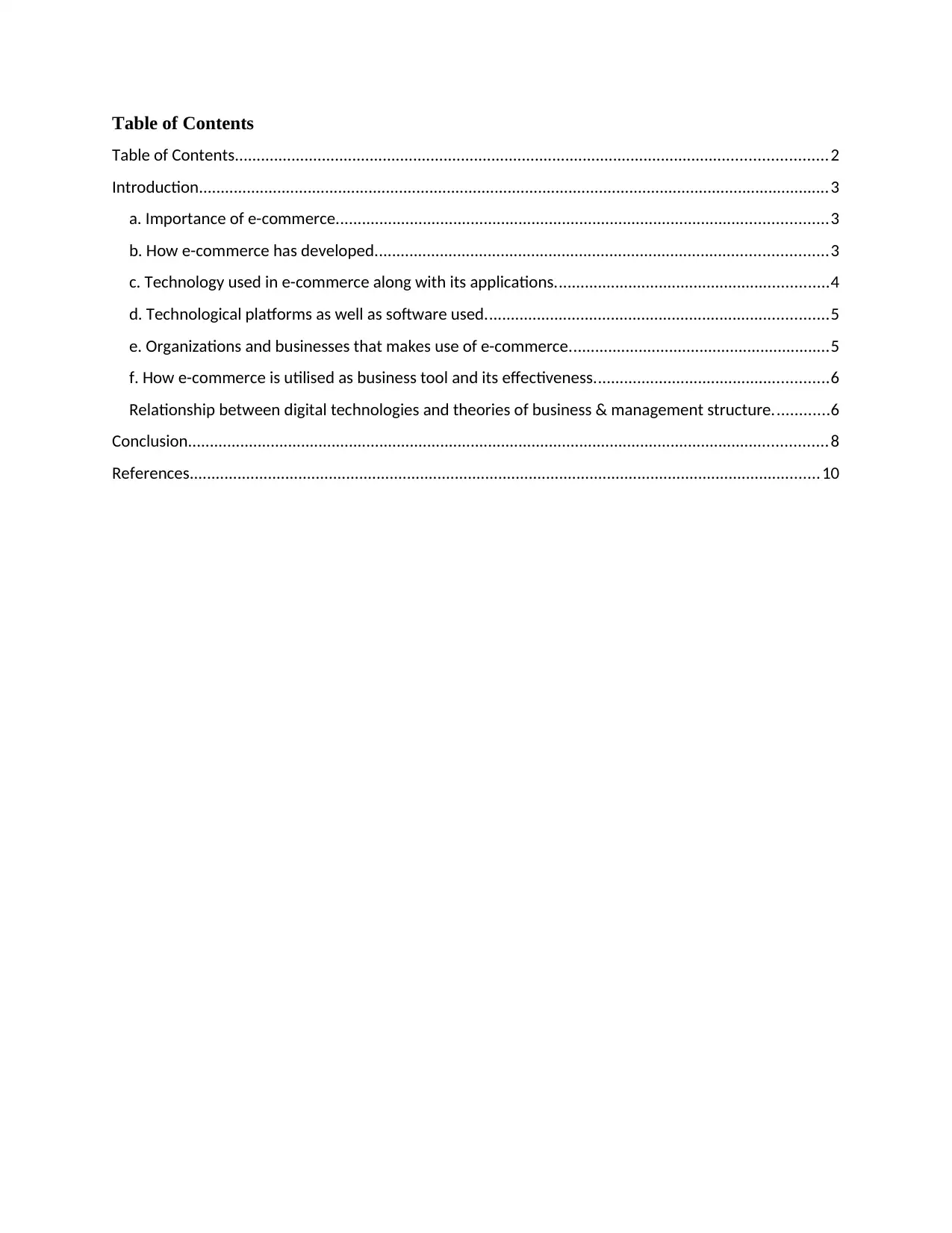
Table of Contents
Table of Contents........................................................................................................................................2
Introduction.................................................................................................................................................3
a. Importance of e-commerce.................................................................................................................3
b. How e-commerce has developed........................................................................................................3
c. Technology used in e-commerce along with its applications...............................................................4
d. Technological platforms as well as software used...............................................................................5
e. Organizations and businesses that makes use of e-commerce............................................................5
f. How e-commerce is utilised as business tool and its effectiveness......................................................6
Relationship between digital technologies and theories of business & management structure.............6
Conclusion...................................................................................................................................................8
References.................................................................................................................................................10
Table of Contents........................................................................................................................................2
Introduction.................................................................................................................................................3
a. Importance of e-commerce.................................................................................................................3
b. How e-commerce has developed........................................................................................................3
c. Technology used in e-commerce along with its applications...............................................................4
d. Technological platforms as well as software used...............................................................................5
e. Organizations and businesses that makes use of e-commerce............................................................5
f. How e-commerce is utilised as business tool and its effectiveness......................................................6
Relationship between digital technologies and theories of business & management structure.............6
Conclusion...................................................................................................................................................8
References.................................................................................................................................................10
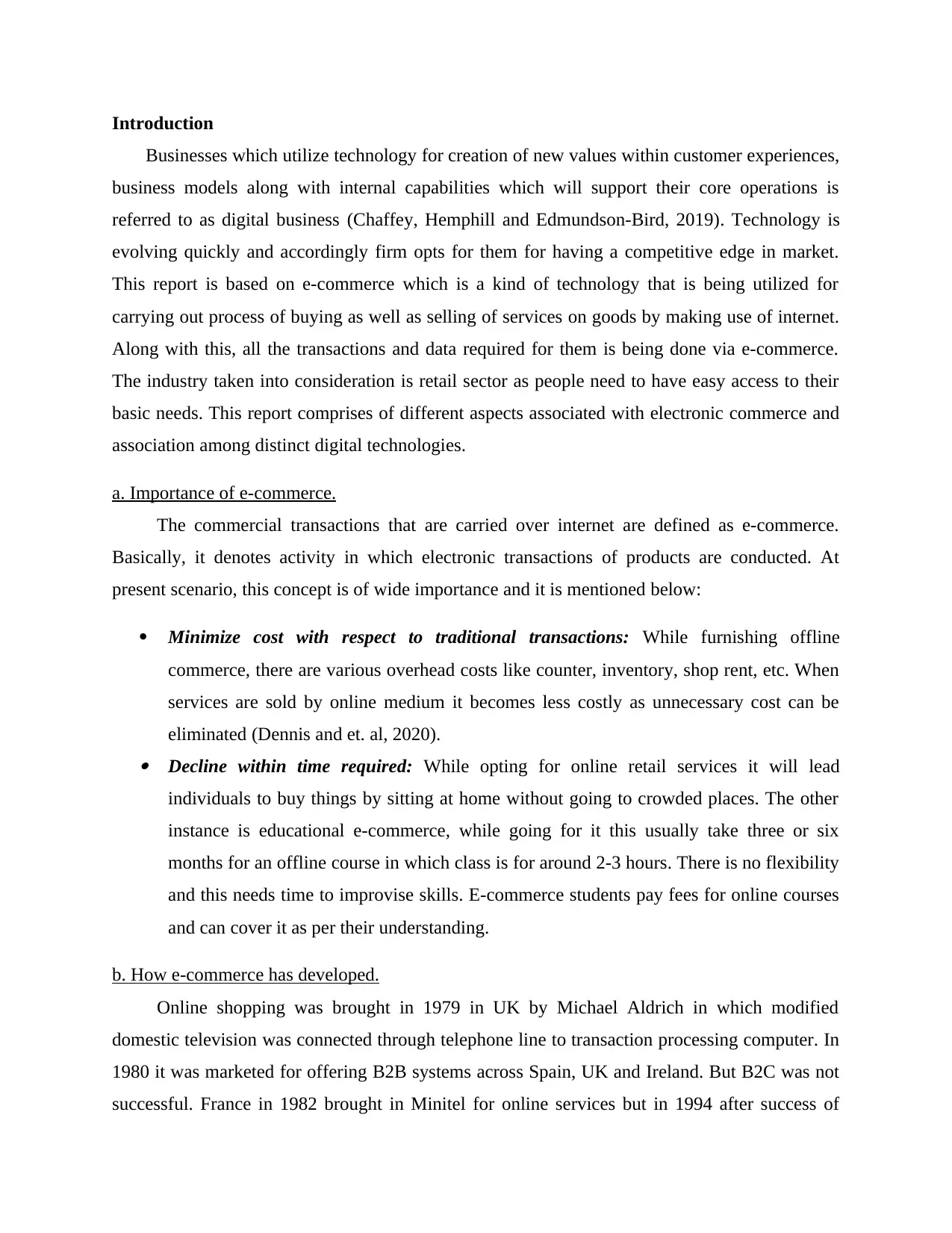
Introduction
Businesses which utilize technology for creation of new values within customer experiences,
business models along with internal capabilities which will support their core operations is
referred to as digital business (Chaffey, Hemphill and Edmundson-Bird, 2019). Technology is
evolving quickly and accordingly firm opts for them for having a competitive edge in market.
This report is based on e-commerce which is a kind of technology that is being utilized for
carrying out process of buying as well as selling of services on goods by making use of internet.
Along with this, all the transactions and data required for them is being done via e-commerce.
The industry taken into consideration is retail sector as people need to have easy access to their
basic needs. This report comprises of different aspects associated with electronic commerce and
association among distinct digital technologies.
a. Importance of e-commerce.
The commercial transactions that are carried over internet are defined as e-commerce.
Basically, it denotes activity in which electronic transactions of products are conducted. At
present scenario, this concept is of wide importance and it is mentioned below:
Minimize cost with respect to traditional transactions: While furnishing offline
commerce, there are various overhead costs like counter, inventory, shop rent, etc. When
services are sold by online medium it becomes less costly as unnecessary cost can be
eliminated (Dennis and et. al, 2020). Decline within time required: While opting for online retail services it will lead
individuals to buy things by sitting at home without going to crowded places. The other
instance is educational e-commerce, while going for it this usually take three or six
months for an offline course in which class is for around 2-3 hours. There is no flexibility
and this needs time to improvise skills. E-commerce students pay fees for online courses
and can cover it as per their understanding.
b. How e-commerce has developed.
Online shopping was brought in 1979 in UK by Michael Aldrich in which modified
domestic television was connected through telephone line to transaction processing computer. In
1980 it was marketed for offering B2B systems across Spain, UK and Ireland. But B2C was not
successful. France in 1982 brought in Minitel for online services but in 1994 after success of
Businesses which utilize technology for creation of new values within customer experiences,
business models along with internal capabilities which will support their core operations is
referred to as digital business (Chaffey, Hemphill and Edmundson-Bird, 2019). Technology is
evolving quickly and accordingly firm opts for them for having a competitive edge in market.
This report is based on e-commerce which is a kind of technology that is being utilized for
carrying out process of buying as well as selling of services on goods by making use of internet.
Along with this, all the transactions and data required for them is being done via e-commerce.
The industry taken into consideration is retail sector as people need to have easy access to their
basic needs. This report comprises of different aspects associated with electronic commerce and
association among distinct digital technologies.
a. Importance of e-commerce.
The commercial transactions that are carried over internet are defined as e-commerce.
Basically, it denotes activity in which electronic transactions of products are conducted. At
present scenario, this concept is of wide importance and it is mentioned below:
Minimize cost with respect to traditional transactions: While furnishing offline
commerce, there are various overhead costs like counter, inventory, shop rent, etc. When
services are sold by online medium it becomes less costly as unnecessary cost can be
eliminated (Dennis and et. al, 2020). Decline within time required: While opting for online retail services it will lead
individuals to buy things by sitting at home without going to crowded places. The other
instance is educational e-commerce, while going for it this usually take three or six
months for an offline course in which class is for around 2-3 hours. There is no flexibility
and this needs time to improvise skills. E-commerce students pay fees for online courses
and can cover it as per their understanding.
b. How e-commerce has developed.
Online shopping was brought in 1979 in UK by Michael Aldrich in which modified
domestic television was connected through telephone line to transaction processing computer. In
1980 it was marketed for offering B2B systems across Spain, UK and Ireland. But B2C was not
successful. France in 1982 brought in Minitel for online services but in 1994 after success of
⊘ This is a preview!⊘
Do you want full access?
Subscribe today to unlock all pages.

Trusted by 1+ million students worldwide

internet it demised (The History Of Ecommerce: How Did It All Begin?, 2020). But due to
security reasons it was not considered safe to make online payments and then it took around 4
years to develop security protocols like DSL and HTTP which provided quick access as well as
persistent connection to internet. At this time, e-commerce was defined as purchasing services
via internet by making use of secured connections along with electronic payment services. After
this sales continued to grow and at the end of 2007 there were around 3.7% sales.
Illustration 1 Retail e-commerce Sales in US from 2016 to 2022
(Source: Ecommerce 101 + The History of Online Shopping: What The Past Says About Tomorrow’s
Retail Challenges. 2020)
c. Technology used in e-commerce along with its applications.
Different technologies and tools are utilized for building up e-commerce store as well as
operating online business successfully. They are illustrated below:
security reasons it was not considered safe to make online payments and then it took around 4
years to develop security protocols like DSL and HTTP which provided quick access as well as
persistent connection to internet. At this time, e-commerce was defined as purchasing services
via internet by making use of secured connections along with electronic payment services. After
this sales continued to grow and at the end of 2007 there were around 3.7% sales.
Illustration 1 Retail e-commerce Sales in US from 2016 to 2022
(Source: Ecommerce 101 + The History of Online Shopping: What The Past Says About Tomorrow’s
Retail Challenges. 2020)
c. Technology used in e-commerce along with its applications.
Different technologies and tools are utilized for building up e-commerce store as well as
operating online business successfully. They are illustrated below:
Paraphrase This Document
Need a fresh take? Get an instant paraphrase of this document with our AI Paraphraser

Web Server: It is being utilized for hosting e-commerce website. Javascript, HTML, PHP
files, media files and database makes up website and they are stored in server (Gould,
2019).
Web Tools: They are utilized for creating front-end of e-commerce website which ranges
from HTML text editors to highly complex graphic and debugging tools. Dreamweaver
and Cascading style sheets are being used for enhancement of visual appearance of site.
Browser Compatibilities: It is a software application that is utilized for locating;
receiving as well as display content that is attained from web server (Hrustek, Mekovec
and Pihir, 2019). For this Google Chrome, Safari, Mozilla Firefox and Internet Explorer
are used.
d. Technological platforms as well as software used.
To have a e-commerce store, firms have different technological options which can be
utilized by them. They are: shopping cart software, e-commerce software and custom e-
commerce platform development. Some reliable software within hosted segment includes
WordPress along with WooCommerce, OpenCart and Magento. Ina ddition to this, some third
party tools are also required by website like CRM, analytical tools, marketing platforms,
payment gateways, etc. Customer data can be collected along with their history by making use of
CRM tools (Ismanto and et. al, 2019). They are Zoho and Salesforce. Analytical tools assist
within bounce & conversion rates and CLV. For this Google analytics, Hotjar and KISSmetrics
can be used. Marketing tools assists e-commerce websites engage visitors, develop brand loyalty
and skyrocket conversion rates. Here, businesses can opt for making use of tools like Hubspot,
Marketo and crowdy.ai.
e. Organizations and businesses that makes use of e-commerce.
Trade has been gone far ahead from offline to e-commerce world. It enables us to make
transactions (selling, buying and making payments for the same) via online medium. Various
firms are making use of e-commerce for doing so. They are listed below:
Amazon Inc.: It was founded on 1994 and started as a online bookstore but at present
they are more than that with largest revenue in the world.
files, media files and database makes up website and they are stored in server (Gould,
2019).
Web Tools: They are utilized for creating front-end of e-commerce website which ranges
from HTML text editors to highly complex graphic and debugging tools. Dreamweaver
and Cascading style sheets are being used for enhancement of visual appearance of site.
Browser Compatibilities: It is a software application that is utilized for locating;
receiving as well as display content that is attained from web server (Hrustek, Mekovec
and Pihir, 2019). For this Google Chrome, Safari, Mozilla Firefox and Internet Explorer
are used.
d. Technological platforms as well as software used.
To have a e-commerce store, firms have different technological options which can be
utilized by them. They are: shopping cart software, e-commerce software and custom e-
commerce platform development. Some reliable software within hosted segment includes
WordPress along with WooCommerce, OpenCart and Magento. Ina ddition to this, some third
party tools are also required by website like CRM, analytical tools, marketing platforms,
payment gateways, etc. Customer data can be collected along with their history by making use of
CRM tools (Ismanto and et. al, 2019). They are Zoho and Salesforce. Analytical tools assist
within bounce & conversion rates and CLV. For this Google analytics, Hotjar and KISSmetrics
can be used. Marketing tools assists e-commerce websites engage visitors, develop brand loyalty
and skyrocket conversion rates. Here, businesses can opt for making use of tools like Hubspot,
Marketo and crowdy.ai.
e. Organizations and businesses that makes use of e-commerce.
Trade has been gone far ahead from offline to e-commerce world. It enables us to make
transactions (selling, buying and making payments for the same) via online medium. Various
firms are making use of e-commerce for doing so. They are listed below:
Amazon Inc.: It was founded on 1994 and started as a online bookstore but at present
they are more than that with largest revenue in the world.
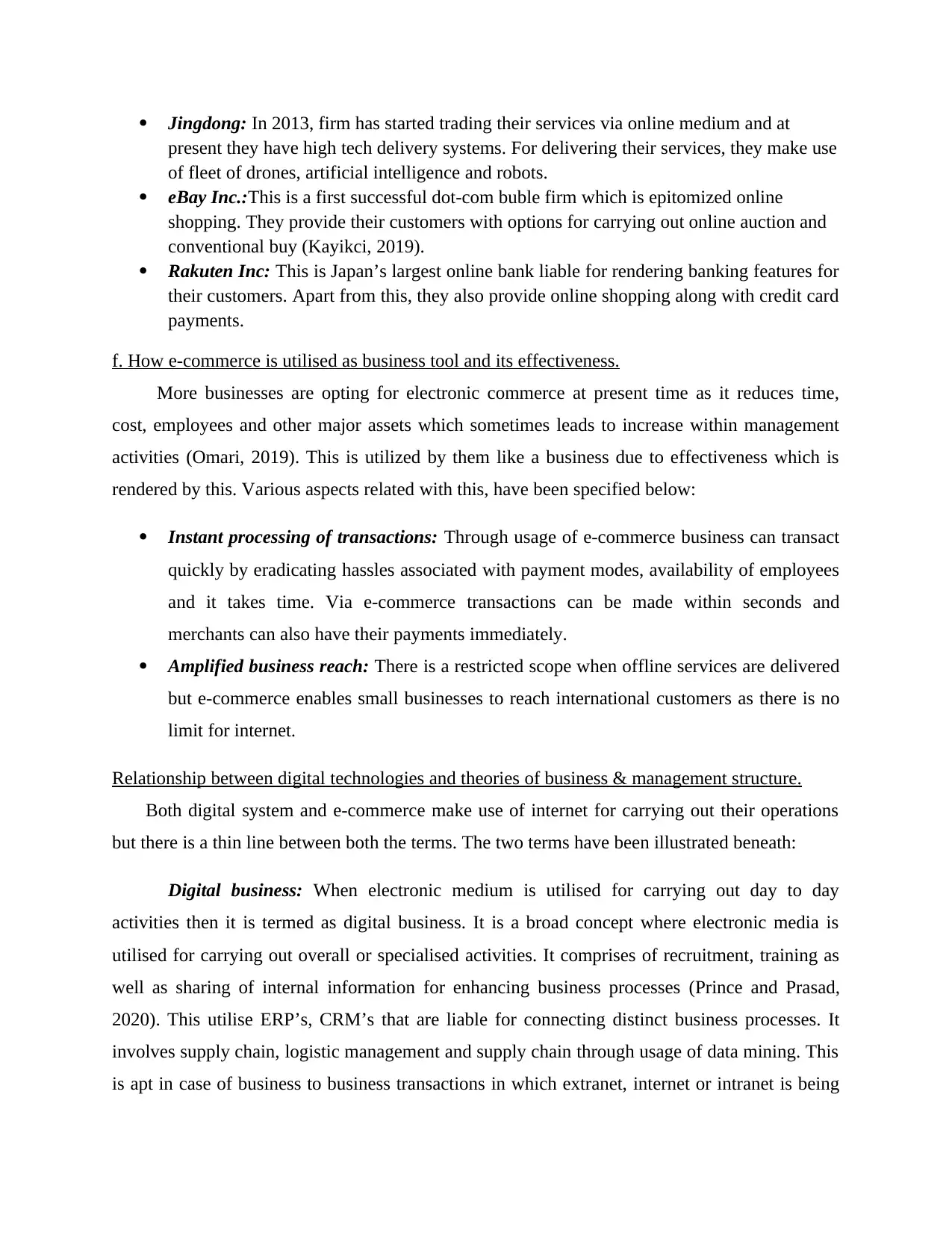
Jingdong: In 2013, firm has started trading their services via online medium and at
present they have high tech delivery systems. For delivering their services, they make use
of fleet of drones, artificial intelligence and robots.
eBay Inc.:This is a first successful dot-com buble firm which is epitomized online
shopping. They provide their customers with options for carrying out online auction and
conventional buy (Kayikci, 2019).
Rakuten Inc: This is Japan’s largest online bank liable for rendering banking features for
their customers. Apart from this, they also provide online shopping along with credit card
payments.
f. How e-commerce is utilised as business tool and its effectiveness.
More businesses are opting for electronic commerce at present time as it reduces time,
cost, employees and other major assets which sometimes leads to increase within management
activities (Omari, 2019). This is utilized by them like a business due to effectiveness which is
rendered by this. Various aspects related with this, have been specified below:
Instant processing of transactions: Through usage of e-commerce business can transact
quickly by eradicating hassles associated with payment modes, availability of employees
and it takes time. Via e-commerce transactions can be made within seconds and
merchants can also have their payments immediately.
Amplified business reach: There is a restricted scope when offline services are delivered
but e-commerce enables small businesses to reach international customers as there is no
limit for internet.
Relationship between digital technologies and theories of business & management structure.
Both digital system and e-commerce make use of internet for carrying out their operations
but there is a thin line between both the terms. The two terms have been illustrated beneath:
Digital business: When electronic medium is utilised for carrying out day to day
activities then it is termed as digital business. It is a broad concept where electronic media is
utilised for carrying out overall or specialised activities. It comprises of recruitment, training as
well as sharing of internal information for enhancing business processes (Prince and Prasad,
2020). This utilise ERP’s, CRM’s that are liable for connecting distinct business processes. It
involves supply chain, logistic management and supply chain through usage of data mining. This
is apt in case of business to business transactions in which extranet, internet or intranet is being
present they have high tech delivery systems. For delivering their services, they make use
of fleet of drones, artificial intelligence and robots.
eBay Inc.:This is a first successful dot-com buble firm which is epitomized online
shopping. They provide their customers with options for carrying out online auction and
conventional buy (Kayikci, 2019).
Rakuten Inc: This is Japan’s largest online bank liable for rendering banking features for
their customers. Apart from this, they also provide online shopping along with credit card
payments.
f. How e-commerce is utilised as business tool and its effectiveness.
More businesses are opting for electronic commerce at present time as it reduces time,
cost, employees and other major assets which sometimes leads to increase within management
activities (Omari, 2019). This is utilized by them like a business due to effectiveness which is
rendered by this. Various aspects related with this, have been specified below:
Instant processing of transactions: Through usage of e-commerce business can transact
quickly by eradicating hassles associated with payment modes, availability of employees
and it takes time. Via e-commerce transactions can be made within seconds and
merchants can also have their payments immediately.
Amplified business reach: There is a restricted scope when offline services are delivered
but e-commerce enables small businesses to reach international customers as there is no
limit for internet.
Relationship between digital technologies and theories of business & management structure.
Both digital system and e-commerce make use of internet for carrying out their operations
but there is a thin line between both the terms. The two terms have been illustrated beneath:
Digital business: When electronic medium is utilised for carrying out day to day
activities then it is termed as digital business. It is a broad concept where electronic media is
utilised for carrying out overall or specialised activities. It comprises of recruitment, training as
well as sharing of internal information for enhancing business processes (Prince and Prasad,
2020). This utilise ERP’s, CRM’s that are liable for connecting distinct business processes. It
involves supply chain, logistic management and supply chain through usage of data mining. This
is apt in case of business to business transactions in which extranet, internet or intranet is being
⊘ This is a preview!⊘
Do you want full access?
Subscribe today to unlock all pages.

Trusted by 1+ million students worldwide
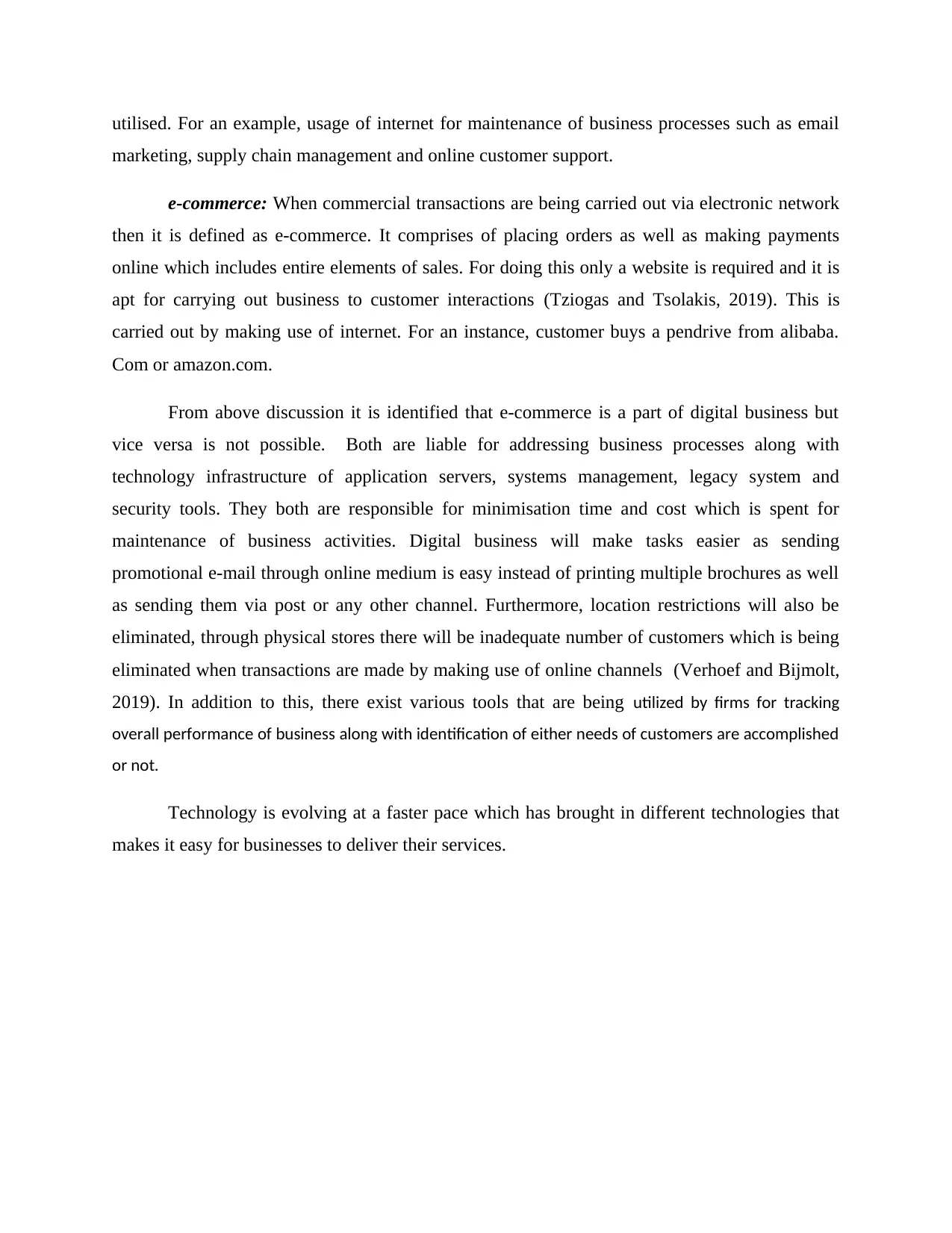
utilised. For an example, usage of internet for maintenance of business processes such as email
marketing, supply chain management and online customer support.
e-commerce: When commercial transactions are being carried out via electronic network
then it is defined as e-commerce. It comprises of placing orders as well as making payments
online which includes entire elements of sales. For doing this only a website is required and it is
apt for carrying out business to customer interactions (Tziogas and Tsolakis, 2019). This is
carried out by making use of internet. For an instance, customer buys a pendrive from alibaba.
Com or amazon.com.
From above discussion it is identified that e-commerce is a part of digital business but
vice versa is not possible. Both are liable for addressing business processes along with
technology infrastructure of application servers, systems management, legacy system and
security tools. They both are responsible for minimisation time and cost which is spent for
maintenance of business activities. Digital business will make tasks easier as sending
promotional e-mail through online medium is easy instead of printing multiple brochures as well
as sending them via post or any other channel. Furthermore, location restrictions will also be
eliminated, through physical stores there will be inadequate number of customers which is being
eliminated when transactions are made by making use of online channels (Verhoef and Bijmolt,
2019). In addition to this, there exist various tools that are being utilized by firms for tracking
overall performance of business along with identification of either needs of customers are accomplished
or not.
Technology is evolving at a faster pace which has brought in different technologies that
makes it easy for businesses to deliver their services.
marketing, supply chain management and online customer support.
e-commerce: When commercial transactions are being carried out via electronic network
then it is defined as e-commerce. It comprises of placing orders as well as making payments
online which includes entire elements of sales. For doing this only a website is required and it is
apt for carrying out business to customer interactions (Tziogas and Tsolakis, 2019). This is
carried out by making use of internet. For an instance, customer buys a pendrive from alibaba.
Com or amazon.com.
From above discussion it is identified that e-commerce is a part of digital business but
vice versa is not possible. Both are liable for addressing business processes along with
technology infrastructure of application servers, systems management, legacy system and
security tools. They both are responsible for minimisation time and cost which is spent for
maintenance of business activities. Digital business will make tasks easier as sending
promotional e-mail through online medium is easy instead of printing multiple brochures as well
as sending them via post or any other channel. Furthermore, location restrictions will also be
eliminated, through physical stores there will be inadequate number of customers which is being
eliminated when transactions are made by making use of online channels (Verhoef and Bijmolt,
2019). In addition to this, there exist various tools that are being utilized by firms for tracking
overall performance of business along with identification of either needs of customers are accomplished
or not.
Technology is evolving at a faster pace which has brought in different technologies that
makes it easy for businesses to deliver their services.
Paraphrase This Document
Need a fresh take? Get an instant paraphrase of this document with our AI Paraphraser
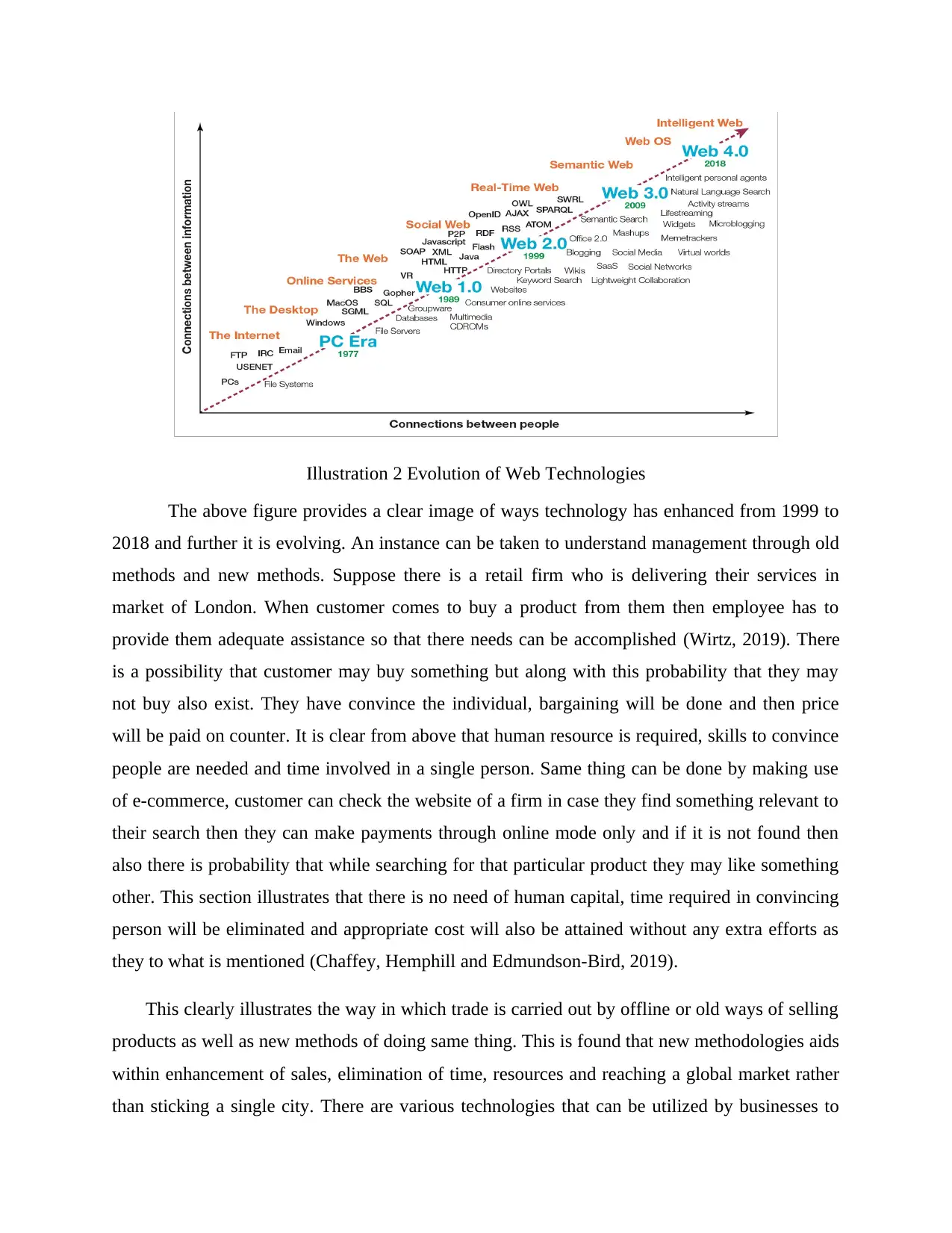
Illustration 2 Evolution of Web Technologies
The above figure provides a clear image of ways technology has enhanced from 1999 to
2018 and further it is evolving. An instance can be taken to understand management through old
methods and new methods. Suppose there is a retail firm who is delivering their services in
market of London. When customer comes to buy a product from them then employee has to
provide them adequate assistance so that there needs can be accomplished (Wirtz, 2019). There
is a possibility that customer may buy something but along with this probability that they may
not buy also exist. They have convince the individual, bargaining will be done and then price
will be paid on counter. It is clear from above that human resource is required, skills to convince
people are needed and time involved in a single person. Same thing can be done by making use
of e-commerce, customer can check the website of a firm in case they find something relevant to
their search then they can make payments through online mode only and if it is not found then
also there is probability that while searching for that particular product they may like something
other. This section illustrates that there is no need of human capital, time required in convincing
person will be eliminated and appropriate cost will also be attained without any extra efforts as
they to what is mentioned (Chaffey, Hemphill and Edmundson-Bird, 2019).
This clearly illustrates the way in which trade is carried out by offline or old ways of selling
products as well as new methods of doing same thing. This is found that new methodologies aids
within enhancement of sales, elimination of time, resources and reaching a global market rather
than sticking a single city. There are various technologies that can be utilized by businesses to
The above figure provides a clear image of ways technology has enhanced from 1999 to
2018 and further it is evolving. An instance can be taken to understand management through old
methods and new methods. Suppose there is a retail firm who is delivering their services in
market of London. When customer comes to buy a product from them then employee has to
provide them adequate assistance so that there needs can be accomplished (Wirtz, 2019). There
is a possibility that customer may buy something but along with this probability that they may
not buy also exist. They have convince the individual, bargaining will be done and then price
will be paid on counter. It is clear from above that human resource is required, skills to convince
people are needed and time involved in a single person. Same thing can be done by making use
of e-commerce, customer can check the website of a firm in case they find something relevant to
their search then they can make payments through online mode only and if it is not found then
also there is probability that while searching for that particular product they may like something
other. This section illustrates that there is no need of human capital, time required in convincing
person will be eliminated and appropriate cost will also be attained without any extra efforts as
they to what is mentioned (Chaffey, Hemphill and Edmundson-Bird, 2019).
This clearly illustrates the way in which trade is carried out by offline or old ways of selling
products as well as new methods of doing same thing. This is found that new methodologies aids
within enhancement of sales, elimination of time, resources and reaching a global market rather
than sticking a single city. There are various technologies that can be utilized by businesses to

ensure maximum ways by which there work can become smooth. Furthermore, it is tough to
expand activities as for these huge investments have to be made. Along with this, it is not easy
for offline firms to deliver their services 24 hours due to certain overheads. This is not the case
with e-commerce as it enables people have easily accessible services. By making use of e-
commerce online store or a single website will do the job and profit attained by this will be high
with minimized hassle (Dennis and et. al, 2020). This denotes that digital business will firm to
have enhanced capabilities in terms of accuracy, processing speed, time, cost related with rent of
a store, salary of employees and their management.
Conclusion
From above it can be concluded that, digital business refers to utilization of technology like
a assets within internal as well as external operations carried out by firm. E-commerce is kind of
a digital business that is liable for rendering a medium by which online transactions either of
commodities, money, education, etc. can be made. For this different technologies are being
utilized so that maximum people can have services as per their requirement. This enhances the
global reach of firms which may not be possible through offline methods. Both businesses and
their customers have adequate benefits from this which renders high levels of satisfaction.
expand activities as for these huge investments have to be made. Along with this, it is not easy
for offline firms to deliver their services 24 hours due to certain overheads. This is not the case
with e-commerce as it enables people have easily accessible services. By making use of e-
commerce online store or a single website will do the job and profit attained by this will be high
with minimized hassle (Dennis and et. al, 2020). This denotes that digital business will firm to
have enhanced capabilities in terms of accuracy, processing speed, time, cost related with rent of
a store, salary of employees and their management.
Conclusion
From above it can be concluded that, digital business refers to utilization of technology like
a assets within internal as well as external operations carried out by firm. E-commerce is kind of
a digital business that is liable for rendering a medium by which online transactions either of
commodities, money, education, etc. can be made. For this different technologies are being
utilized so that maximum people can have services as per their requirement. This enhances the
global reach of firms which may not be possible through offline methods. Both businesses and
their customers have adequate benefits from this which renders high levels of satisfaction.
⊘ This is a preview!⊘
Do you want full access?
Subscribe today to unlock all pages.

Trusted by 1+ million students worldwide
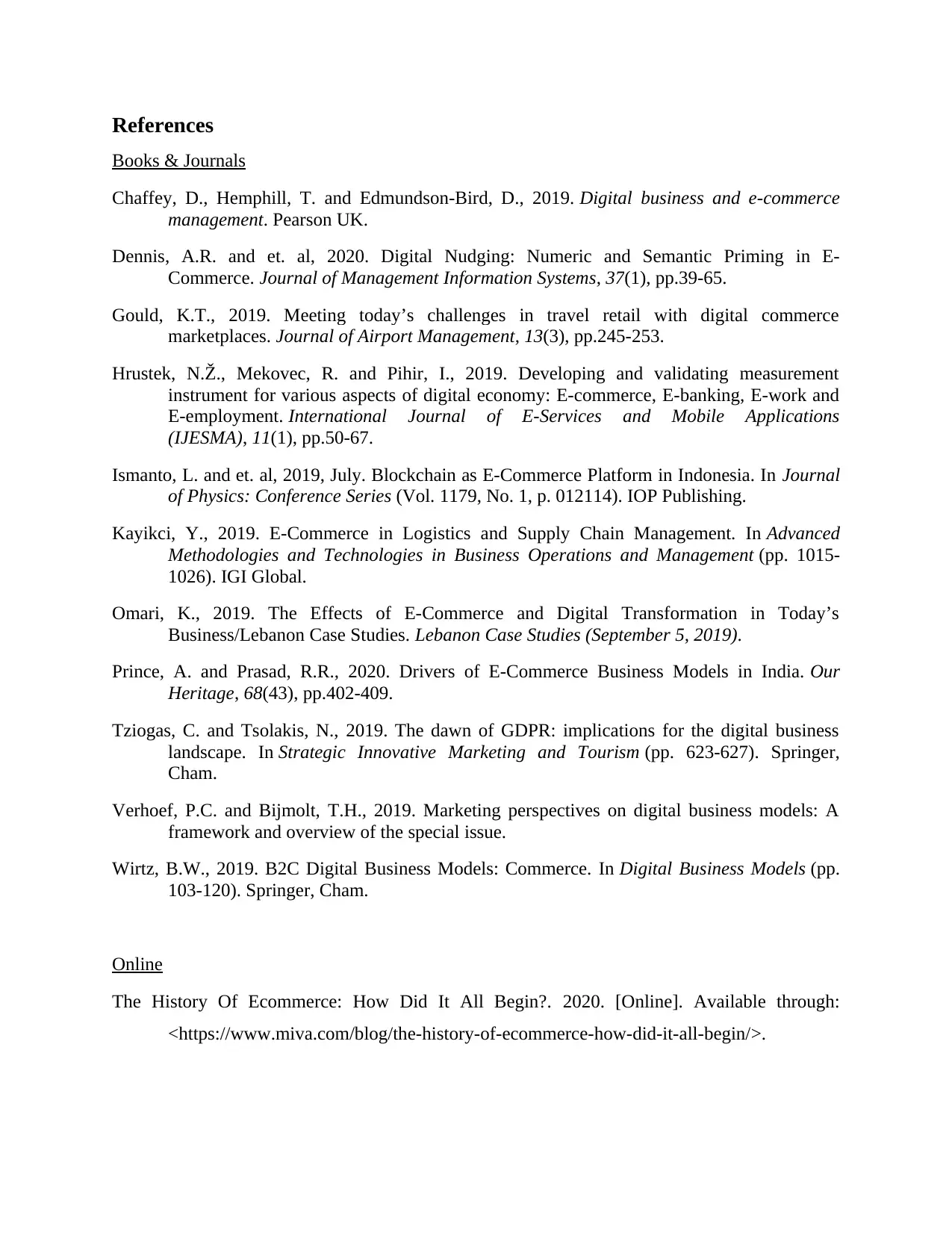
References
Books & Journals
Chaffey, D., Hemphill, T. and Edmundson-Bird, D., 2019. Digital business and e-commerce
management. Pearson UK.
Dennis, A.R. and et. al, 2020. Digital Nudging: Numeric and Semantic Priming in E-
Commerce. Journal of Management Information Systems, 37(1), pp.39-65.
Gould, K.T., 2019. Meeting today’s challenges in travel retail with digital commerce
marketplaces. Journal of Airport Management, 13(3), pp.245-253.
Hrustek, N.Ž., Mekovec, R. and Pihir, I., 2019. Developing and validating measurement
instrument for various aspects of digital economy: E-commerce, E-banking, E-work and
E-employment. International Journal of E-Services and Mobile Applications
(IJESMA), 11(1), pp.50-67.
Ismanto, L. and et. al, 2019, July. Blockchain as E-Commerce Platform in Indonesia. In Journal
of Physics: Conference Series (Vol. 1179, No. 1, p. 012114). IOP Publishing.
Kayikci, Y., 2019. E-Commerce in Logistics and Supply Chain Management. In Advanced
Methodologies and Technologies in Business Operations and Management (pp. 1015-
1026). IGI Global.
Omari, K., 2019. The Effects of E-Commerce and Digital Transformation in Today’s
Business/Lebanon Case Studies. Lebanon Case Studies (September 5, 2019).
Prince, A. and Prasad, R.R., 2020. Drivers of E-Commerce Business Models in India. Our
Heritage, 68(43), pp.402-409.
Tziogas, C. and Tsolakis, N., 2019. The dawn of GDPR: implications for the digital business
landscape. In Strategic Innovative Marketing and Tourism (pp. 623-627). Springer,
Cham.
Verhoef, P.C. and Bijmolt, T.H., 2019. Marketing perspectives on digital business models: A
framework and overview of the special issue.
Wirtz, B.W., 2019. B2C Digital Business Models: Commerce. In Digital Business Models (pp.
103-120). Springer, Cham.
Online
The History Of Ecommerce: How Did It All Begin?. 2020. [Online]. Available through:
<https://www.miva.com/blog/the-history-of-ecommerce-how-did-it-all-begin/>.
Books & Journals
Chaffey, D., Hemphill, T. and Edmundson-Bird, D., 2019. Digital business and e-commerce
management. Pearson UK.
Dennis, A.R. and et. al, 2020. Digital Nudging: Numeric and Semantic Priming in E-
Commerce. Journal of Management Information Systems, 37(1), pp.39-65.
Gould, K.T., 2019. Meeting today’s challenges in travel retail with digital commerce
marketplaces. Journal of Airport Management, 13(3), pp.245-253.
Hrustek, N.Ž., Mekovec, R. and Pihir, I., 2019. Developing and validating measurement
instrument for various aspects of digital economy: E-commerce, E-banking, E-work and
E-employment. International Journal of E-Services and Mobile Applications
(IJESMA), 11(1), pp.50-67.
Ismanto, L. and et. al, 2019, July. Blockchain as E-Commerce Platform in Indonesia. In Journal
of Physics: Conference Series (Vol. 1179, No. 1, p. 012114). IOP Publishing.
Kayikci, Y., 2019. E-Commerce in Logistics and Supply Chain Management. In Advanced
Methodologies and Technologies in Business Operations and Management (pp. 1015-
1026). IGI Global.
Omari, K., 2019. The Effects of E-Commerce and Digital Transformation in Today’s
Business/Lebanon Case Studies. Lebanon Case Studies (September 5, 2019).
Prince, A. and Prasad, R.R., 2020. Drivers of E-Commerce Business Models in India. Our
Heritage, 68(43), pp.402-409.
Tziogas, C. and Tsolakis, N., 2019. The dawn of GDPR: implications for the digital business
landscape. In Strategic Innovative Marketing and Tourism (pp. 623-627). Springer,
Cham.
Verhoef, P.C. and Bijmolt, T.H., 2019. Marketing perspectives on digital business models: A
framework and overview of the special issue.
Wirtz, B.W., 2019. B2C Digital Business Models: Commerce. In Digital Business Models (pp.
103-120). Springer, Cham.
Online
The History Of Ecommerce: How Did It All Begin?. 2020. [Online]. Available through:
<https://www.miva.com/blog/the-history-of-ecommerce-how-did-it-all-begin/>.
Paraphrase This Document
Need a fresh take? Get an instant paraphrase of this document with our AI Paraphraser

Ecommerce 101 + The History of Online Shopping: What The Past Says About Tomorrow’s Retail
Challenges. 2020. [Online]. Available through: <
https://www.bigcommerce.com/blog/ecommerce/#additional-ecommerce-resources >.
Challenges. 2020. [Online]. Available through: <
https://www.bigcommerce.com/blog/ecommerce/#additional-ecommerce-resources >.
1 out of 11
Related Documents
Your All-in-One AI-Powered Toolkit for Academic Success.
+13062052269
info@desklib.com
Available 24*7 on WhatsApp / Email
![[object Object]](/_next/static/media/star-bottom.7253800d.svg)
Unlock your academic potential
Copyright © 2020–2025 A2Z Services. All Rights Reserved. Developed and managed by ZUCOL.




